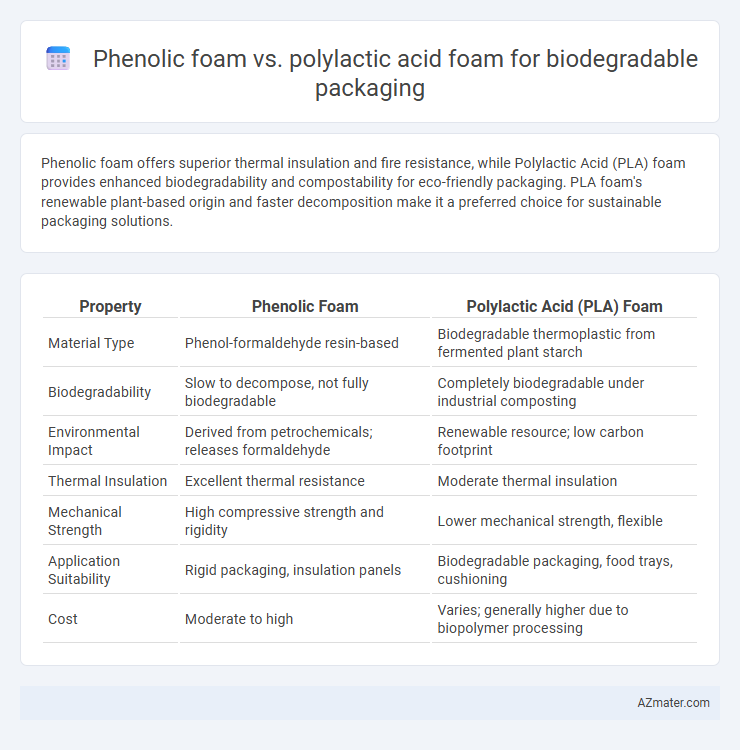Phenolic foam offers superior thermal insulation and fire resistance, while Polylactic Acid (PLA) foam provides enhanced biodegradability and compostability for eco-friendly packaging. PLA foam's renewable plant-based origin and faster decomposition make it a preferred choice for sustainable packaging solutions.
Table of Comparison
| Property | Phenolic Foam | Polylactic Acid (PLA) Foam |
|---|---|---|
| Material Type | Phenol-formaldehyde resin-based | Biodegradable thermoplastic from fermented plant starch |
| Biodegradability | Slow to decompose, not fully biodegradable | Completely biodegradable under industrial composting |
| Environmental Impact | Derived from petrochemicals; releases formaldehyde | Renewable resource; low carbon footprint |
| Thermal Insulation | Excellent thermal resistance | Moderate thermal insulation |
| Mechanical Strength | High compressive strength and rigidity | Lower mechanical strength, flexible |
| Application Suitability | Rigid packaging, insulation panels | Biodegradable packaging, food trays, cushioning |
| Cost | Moderate to high | Varies; generally higher due to biopolymer processing |
Overview of Biodegradable Packaging Materials
Phenolic foam and polylactic acid (PLA) foam serve as innovative materials in biodegradable packaging, each offering unique properties and environmental benefits. Phenolic foam is known for its excellent thermal insulation and fire resistance but degrades more slowly compared to PLA foam, which is derived from renewable resources like corn starch and offers rapid compostability under industrial conditions. PLA foam is favored for sustainable packaging solutions due to its lower carbon footprint and compatibility with existing composting infrastructure, making it a more environmentally friendly choice in biodegradable packaging applications.
Introduction to Phenolic Foam
Phenolic foam, derived from phenol-formaldehyde resin, is a rigid, lightweight material with excellent thermal insulation and fire-resistant properties, making it a popular choice in packaging applications. Its closed-cell structure provides high mechanical strength and moisture resistance, which extends the shelf life of packaged products. Compared to polylactic acid foam, phenolic foam offers superior durability but requires careful waste management due to its slower biodegradation rate.
Introduction to Polylactic Acid (PLA) Foam
Polylactic Acid (PLA) foam is a biodegradable packaging material derived from renewable resources such as corn starch and sugarcane, offering a sustainable alternative to conventional plastics. It exhibits excellent biodegradability and compostability under industrial composting conditions, reducing environmental pollution and reliance on fossil fuels. PLA foam's lightweight structure and thermal insulation properties make it suitable for protective packaging applications while aligning with eco-friendly waste management practices.
Raw Material Sources and Sustainability
Phenolic foam is derived from petrochemical-based phenol and formaldehyde, which limits its sustainability due to fossil fuel dependency and non-renewable raw materials. Polylactic acid (PLA) foam is produced from renewable biomass sources such as corn starch or sugarcane, offering enhanced biodegradability and a lower carbon footprint. The renewable origin of PLA supports circular economy principles, making it a more sustainable option for biodegradable packaging compared to phenolic foam.
Manufacturing Processes Compared
Phenolic foam is produced through a chemical reaction involving phenol and formaldehyde, resulting in a rigid, thermosetting polymer with high thermal resistance and flame retardancy. Polylactic acid (PLA) foam is manufactured using a biopolymer derived from renewable resources like corn starch or sugarcane, which undergoes extrusion and foaming processes to create a biodegradable, compostable material. The phenolic foam manufacturing involves toxic chemicals and complex curing steps, whereas PLA foam manufacturing promotes sustainability with less environmental impact and simpler processing techniques.
Biodegradability and Environmental Impact
Phenolic foam exhibits slower biodegradability due to its synthetic resin base, resulting in longer environmental persistence and potential microplastic formation. Polylactic acid (PLA) foam, derived from renewable plant starches, offers enhanced biodegradability with microbial assimilation in industrial composting environments within months. PLA foam significantly reduces greenhouse gas emissions and dependence on fossil fuels, positioning it as a more sustainable option for eco-friendly packaging solutions.
Performance and Protective Properties
Phenolic foam demonstrates superior fire resistance and thermal insulation, making it ideal for packaging sensitive goods requiring robust protection against heat and mechanical impact. Polylactic acid (PLA) foam excels in biodegradability and environmental sustainability, offering good cushioning but lower durability and moisture resistance compared to phenolic foam. The choice between phenolic and PLA foam depends on balancing high-performance protective properties with eco-friendly disposal requirements in biodegradable packaging applications.
Cost Analysis: Phenolic Foam vs PLA Foam
Phenolic foam typically incurs lower raw material and production costs compared to polylactic acid (PLA) foam, making it more cost-effective for large-scale biodegradable packaging applications. PLA foam, derived from renewable resources like corn starch, often commands higher prices due to complex fermentation and polymerization processes, impacting overall manufacturing expenses. Despite the higher initial cost, PLA foam may offer long-term economic benefits through enhanced biodegradability and alignment with environmental regulations promoting sustainable packaging solutions.
Market Applications and Industry Adoption
Phenolic foam is widely utilized in industrial insulation and fire-resistant packaging due to its superior thermal stability and flame retardancy, making it favorable in construction and electronics sectors. Polylactic acid (PLA) foam, derived from renewable resources, dominates the biodegradable packaging market with strong adoption in food service and consumer goods industries seeking compostable and eco-friendly solutions. Industry adoption favors PLA foam for its biodegradability and regulatory compliance in sustainable packaging, while phenolic foam remains critical where performance under extreme conditions is paramount.
Future Prospects and Innovation Trends
Phenolic foam offers superior thermal insulation and fire resistance, positioning it as a durable option for biodegradable packaging enhancements, while polylactic acid (PLA) foam excels in compostability and compatibility with renewable resources, driving innovation in eco-friendly materials. Future prospects include the integration of nanotechnology to improve mechanical strength and biodegradability of both foams, alongside advances in bio-based additives that optimize performance and environmental impact. Emerging trends emphasize scalable manufacturing processes and circular economy models that leverage PLA foam's natural polymer structure and phenolic foam's chemical stability for sustainable packaging solutions.

Infographic: Phenolic foam vs Polylactic acid foam for Biodegradable packaging
 azmater.com
azmater.com